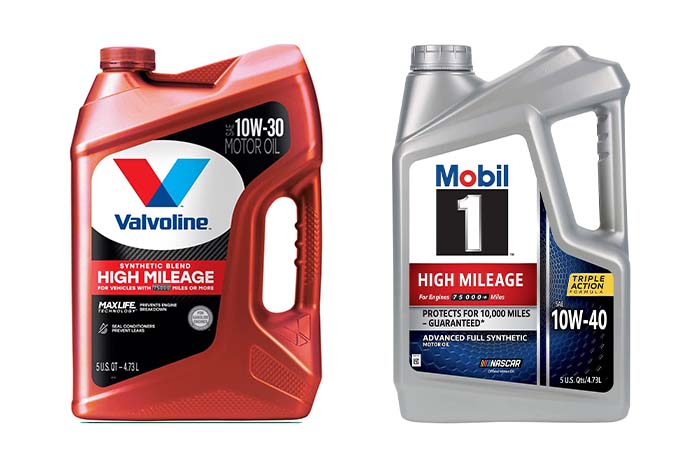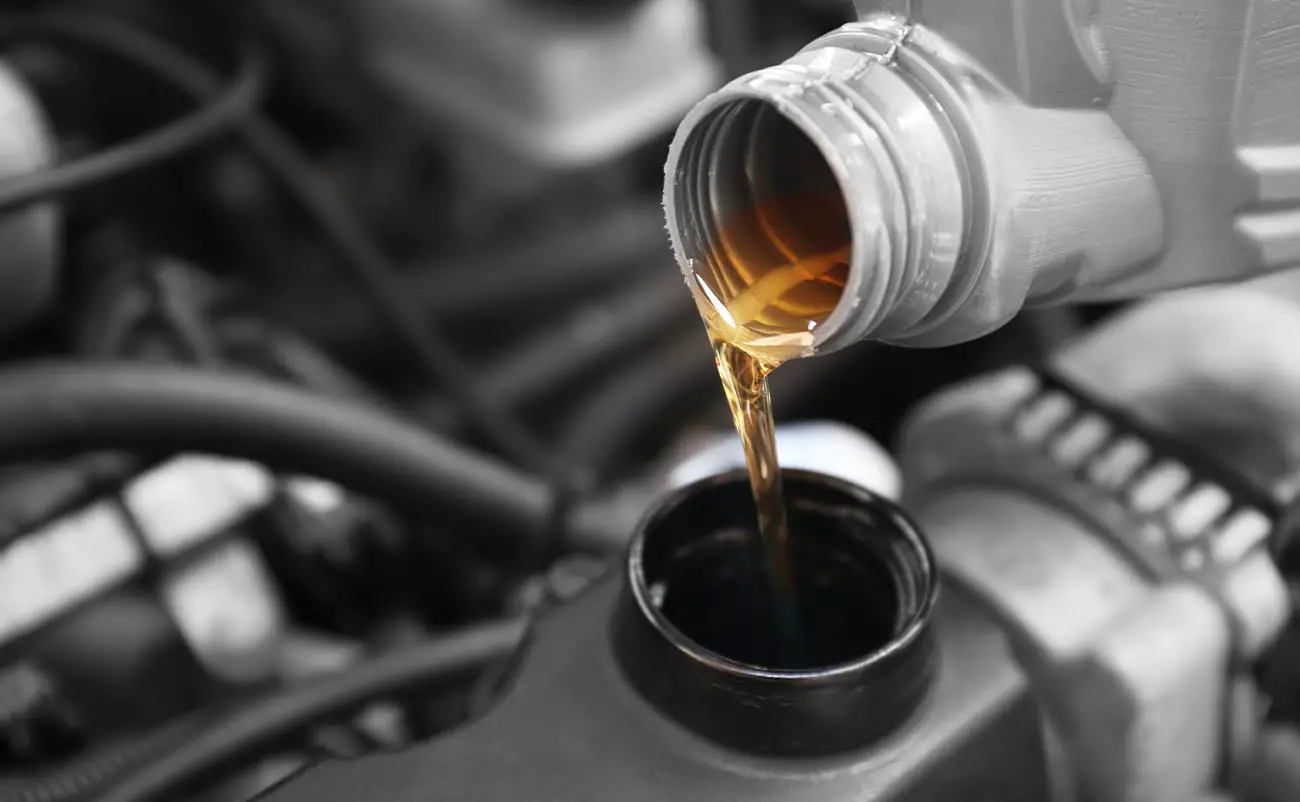Engine oil comes in different weights, and the numbers can sometimes get confusing. Some oil only has one number associated with the weight, while other types of oil have two numbers. 10W30 oil and 10W40 oil might not sound that different, but there is a significant difference between the two. Using the wrong kind of oil in your vehicle could create problems for your engine.
So, what is the difference between 10W30 and 10W40 engine oil, and which one should you use in your car? Keep reading as we give you all the details. We will tell you the difference between the two and help you decide on the right one for your vehicle. Let’s dive into the details!
Table of Contents
What Is Engine Oil Viscosity?

Viscosity describes the thickness of your engine oil, and it also describes how easily the oil will flow through the engine. A lower viscosity describes a thinner oil, while a higher viscosity describes a thicker oil. Think about these common liquids as an example. Water would have a very low viscosity because it is thin and flows easily from one place to another. Honey, on the other hand, would have a high viscosity because it is thick and flows very slowly.
The Society of Automotive Engineers (SAE) has developed standards for viscosity ratings. By using these standards, you can be sure that an oil’s thickness is the same from one manufacturer to the next. For example, an oil with a viscosity rating of 30 from one manufacturer will be the same thickness as oil from another manufacturer with the same rating.
Oil viscosity ratings are consistent, even between conventional oil and synthetic oil. Conventional oil is made from refined crude oil, while synthetic oil has undergone a chemical process that removes impurities and standardizes the oil’s molecule size. Synthetic oil can withstand extremely high temperatures without breaking down, and most people agree that it performs better in today’s modern engines.
You might have already noticed that many oils contain two numbers as part of their viscosity rating. Oil with only one number is called single-grade oil, while oil with two numbers is known as multi-grade oil. Here is the difference. Single-grade oil remains at the same viscosity all the time, while multi-grade oil changes its thickness based on the temperature. For example, SAE 30 oil will always be the same thickness regardless of the temperature. This kind of oil is typically used in small engines, like lawnmowers.
When looking at multi-grade oil, the first number describes the oil’s viscosity at cold temperatures. The ‘W’ in the rating literally refers to winter. This number notifies you how thick the oil will be at engine startup in low temperatures — around 32 degrees Fahrenheit. The second number describes the oil’s viscosity at high temperatures or engine operating temperature — around 200 degrees Fahrenheit. The polymers in multi-grade oil expand as the temperature increases, thus increasing the thickness of the oil at higher temperatures.
Thick oil provides better lubrication of your engine’s internal components, while thin oil is better for cold starts because the oil flows quickly to all parts of the car engine. This is one of the main reasons that the low-temperature viscosity and high-temperature viscosity of oil need to be different. Now, let’s look at the key differences between 10W30 oil and 10W40 oil.
10W30 vs. 10W40 Motor Oil Comparison

Let’s take a look at the differences between these two types of oil across a few categories. You might be surprised to learn that there are more differences than you think. Here is how these two oils compare.
— Cold Weather Viscosity
We have already discussed the fact that multi-grade oil has a different thickness in cold temperatures versus hot temperatures. 10W30 motor oil and 10W40 motor oil have the same cold weather viscosity rating, similar to comparing 5W20 versus 5W30. Since viscosity grades have been standardized across the industry, the thickness of these two oils will be the same in cold weather. The viscosity of the oil at engine startup allows for fairly quick flow throughout the engine, although not as quick as a ‘0’ or ‘5’ grade oil. Some modern engines require formulations with very low viscosity at startup, as oil with a ‘10’ rating is generally used in older vehicles.
— Warm Weather Viscosity
The warm weather viscosity is the most significant difference between 10W30 and 10W40 oil. At engine operating temperature, 10W30 will be thinner than 10W40 weight oil. Although the thickness of the oil will increase slightly in hot weather, the difference really shows up at oil temperatures above 200 degrees Fahrenheit. Higher viscosity oil will be thicker, and it will do a better job of lubricating the moving parts of your vehicle’s engine. Consider the comparison between 5W-30 versus 10W-30 oil. In that case, the two oils would have different cold weather viscosities but the same high-temperature viscosity.
— Additives
Engine oil often contains additives to increase its effectiveness and provide additional protection for your engine. Additives may include seal and gasket conditioners and detergents to help reduce sludge buildup. High-mileage oil almost always contains these additives. However, there is no consistent difference in additives when it comes to 10W30 versus 10W40 oil. The additives contained in the oil depend on the brand in most cases. Some brands may contain more or different additives than other brands. If you purchase 10W30 and 10W40 oil from the same brand, the two types of oil might have the same additives. The only way to determine the specific additives in the oil you are purchasing is to read the label.
— Gas Mileage
Many people think that the only difference between 10W30 and 10W40 is the viscosity at high temperatures. However, that is not exactly the case! While that may be the only physical difference between the two, the oil’s thickness can have a downstream effect. Thicker oil creates more drag on the moving parts of your engine, and it can lead to lower fuel efficiency. Similarly, thick oil can cause slightly lower horsepower from your engine than thin oil. Although it will not likely be a huge difference, you might find your fuel economy to be just a little lower when you use a heavier oil weight.
— High Mileage Engines
Many people believe that a thicker oil is better for high-mileage engines. A high-mileage engine usually has higher tolerances and slightly more space between internal components due to the wear the engine has experienced. Thicker oil can do a better job of lubricating these parts. For that reason, 10W40 might be a better choice than 10W30. While the oil will still be thin enough at startup to flow through the oil passages quickly, the slightly higher viscosity at operating temperature will provide the additional lubrication needed for older engines. Similarly, you should look specifically for high-mileage engine oil because it contains additives that help condition and restore seals to stop leaks. One of the best high-mileage engine oils available is Valvoline High-Mileage 10W-30 Synthetic Blend. This oil provides superior lubrication to your engine. It also helps reduce sludge, and the oil prevents leaks by restoring and conditioning the engine’s seals. The next best alternative is Mobil 1 High-Mileage 10W-40 Full Synthetic. Mobil 1’s product is also a fully synthetic oil that can help prevent leaks, damaging deposits, and sludge buildup. Both of these products are available from Amazon and other retailers.
10W30 vs. 10W40: Which Is Better?
So, which oil is better? The answer really depends on your specific vehicle. Since your manufacturer knows your engine best, you should always follow their recommendation when selecting the right type of oil. Refer to your owner’s manual to determine which type of oil should be used in your vehicle. Using the wrong kind of oil could potentially lead to improper oil pressure, damage to your oil pump, or damage to the internal components of your engine.
You might find that your owner’s manual recommends more than one type of oil, and the recommendation might depend on the weather conditions in your area. If you live in a very hot climate, you might need to use 10W40 because of the improved lubrication it provides in hot temperatures. Thicker oil will generally perform better in extreme temperatures and keep your engine cooler. However, make sure that your vehicle is capable of handling a thicker oil before pouring it in.
The key here is to use the oil type recommended in your owner’s manual. Even though your friend might tell you a certain kind of oil is better for your vehicle, you should always follow the advice of your manufacturer. After all, they designed and produced your engine, so they should know what works best! Using the wrong kind of oil can even void your warranty in some cases, so don’t fall into the trap of using something different just because someone shares their opinion with you.
Can You Mix 10W30 And 10W40 Motor Oil?
You should avoid mixing 10W30 and 10W40 motor oil whenever possible. Mixing the two oils could cause you to have the wrong oil viscosity in your car. If your vehicle requires 10W30, you could make the oil too thick by mixing 10W40 into it. Likewise, you could make your oil too thin by mixing a lower-weight oil.
In an emergency situation, you should be able to mix 10W30 with 10W40 without seeing any immediate damage. However, make sure that you perform an oil change as soon as possible after mixing two types of oil in your engine. Drain all the old oil and refill the engine with the type recommended in your owner’s manual. If you must mix oil, you should at least try to use the same brand. This will help ensure that the additives in the oil remain consistent from one to the next.
The Bottom Line
Today’s engine oil is quite complex, and multi-grade oil changes thickness based on the temperature. 10W30 oil and 10W40 oil have the same thickness at low temperatures, but 10W40 is thicker than 10W30 at high temperatures. This additional thickness can provide better lubrication, but it can also put more strain on your oil pump and be slower to reach some parts of the engine. Make sure you always follow your manufacturer’s recommendation when selecting an oil type, and you should have no issues with the oil in your vehicle.
Frequently Asked Questions
What are the differences between 10W30 and 10W40?
The main difference between 10W30 and 10W40 oil is the high-temperature viscosity. 10W40 oil will be a little thicker than 10W30 at high temperatures. Once your engine reaches operating temperature, the difference in thickness can affect the lubrication of your engine’s internal parts. 10W40 oil will provide better lubrication at high temperatures, although a thicker oil can also reduce your fuel economy and horsepower. Regardless of the differences in these types of oil, you should always use the oil recommended in your owner’s manual for your vehicle.
Why is 10W30 oil better for cold weather than 10W40?
10W30 oil is better for cold weather than 10W40 because it is slightly thinner than 10W40 at your engine’s operating temperature. Since 10W40 is thicker, it usually performs better in high temperatures because it provides better lubrication and keeps the engine running slightly cooler. 10W30 flows more easily because it is thinner than 10W40 when it is hot. A thinner oil typically works better for cold weather because it will flow more easily through the passages in the engine.
Can I use 10W30 oil in a motorcycle?
You should not generally use 10W30 auto engine oil in a motorcycle. A car has different fluids that cool and lubricate different parts of the vehicle. For example, oil lubricates the engine, while transmission fluid lubricates the transmission. A separate cooling system also keeps things from overheating. However, a motorcycle uses oil to lubricate the engine, gearbox, and other parts. Auto engine oil is not made to perform all these functions. While you could temporarily use 10W30 auto oil in a motorcycle, you should not do so for long. Use oil that is specifically formulated for use in motorcycles.
Is 10W30 or 10W40 oil better for heavy-duty applications?
10W40 oil is better than 10W30 for heavy-duty applications. 10W40 oil is thicker than 10W30 at high temperatures, and heavy-duty applications often run at a higher temperature than light-duty vehicles. Heavy-duty vehicles often carry heavy loads and run for many hours at a time. For this reason, they need a thicker oil that can provide better lubrication and cooling for the system. Thin oil might cause the engine in a heavy-duty vehicle to overheat. Some heavy-duty applications require oil with a weight even greater than 40, but you should always use the type of oil specified by the manufacturer.

